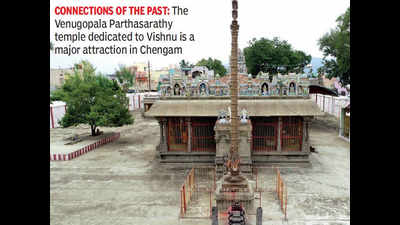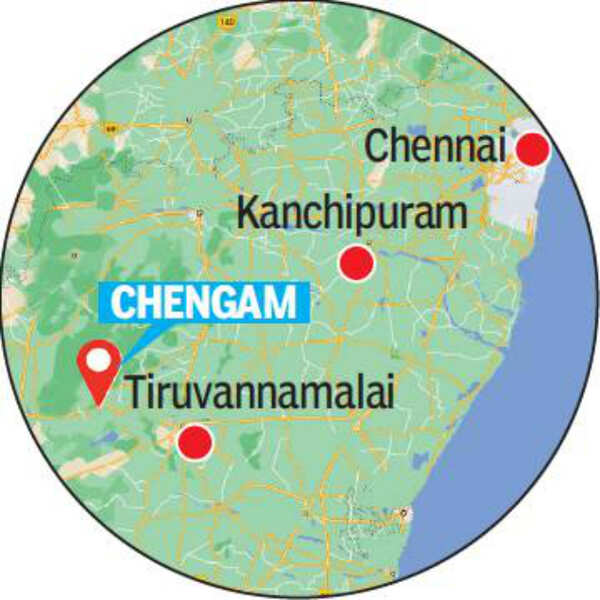- News
- City News
- chennai News
- Tracing a Sangam trade route in Tiruvannamalai
Trending
This story is from October 8, 2020
Tracing a Sangam trade route in Tiruvannamalai
Situated on the banks of Cheyyar, Chengam in Tiruvannamalai was part of a trade route for several centuries, connecting the eastern shore to the deep south. Chola inscriptions

The Venugopala Parthasarathy temple dedicated to Vishnu is a major attraction in Chengam
CHENNAI: Situated on the banks of Cheyyar, Chengam in Tiruvannamalai was part of a trade route for several centuries, connecting the eastern shore to the deep south. Chola inscriptions, Vijayanagara temples, local legends, colonial vestiges, and more have painted this village’s cultural fabric with a splash of colours, according to architect Madhusudhanan Kalaichelvan, who won the inaugural edition of the Tamil Heritage Trust (THT) Professor S Swaminathan Heritage Award recently.

Chengam, according to Kalaichelvan, has been well-documented in the works of the Sangam era.“Malaipadukadaam”, a Sangam anthology, describes the route to Chengam cutting across the Jawadhu Hills. More than 2,000 years ago, a poet negotiated this challenging trek filled with wild beasts with the help of hospitable residents of the hills. Walking parallel to the stream of Cheyyar, he reached Chenagm, the capital city of Nannan Sei Nannan, a king who ruled this part of today’s Tamil Nadu,” said Kalaichelvan, who had worked as senior consultant to document more than 300 heritage structures in Kancheepuram for the Union government’s HRIDAY project between 2014 and 2015.
Historians say a palace of Nannan Sei Nannan once existed there. “The place where the palatial mansions of this king once stood is identified as ‘Kottai Medu’ to the east of the village today. Several excavations have unearthed proof to conclude that a brick palace stood there several centuries ago,” he said.
The area has two main temples, dedicated to Shiva and Vishnu. “Rishabeshwarar as Shiva is addressed now has stood witness to changes for around a millennium and a half now. Inscriptions mentioning a long list of castes that took part in political discussions, inscriptions that are poetic, details on local chieftains are interesting titbits that you get here,” he said. The Vishnu shrine dedicated to Krishna as Venugopala Parthasarathy is a quite an attrction. A 17th century Nayak style shrine patronised by Thalavai Thimmappa Nayaka has exquisite sculptures that makes the ‘mahamadapam’ an art gallery. The mural paintings depicting episodes from Ramayana makes it more special, said Kalaichelvan. “Several scenes that are not described in popular versions of Ramayana are elaborately shown here.”
The town is on the main highway connecting Karnataka to the east coast. “It was abuzz with activity since the Sangam era and continued to remain so till the colonial period. The massive elephant structure exhibited in the central hall of Egmore Government Museum is the skeletal remains of the elephant that was shot to death in Chengam in late 1800s,” said Kalaichelvan.
The THT-Prof S Swaminathan Heritage Award aims to recognise an individual who has made exceptional contributions towards the understanding, dissemination and preservation of Indian heritage. Kalaichelvan decided to speak about Chengam for the award lecture to honour retired IIT professor and founder of THT S Swaminathan’s cherished dream of collating what he calls a ‘Culture Atlas’- a manual that documents every settlement for its history, culture, arts, flora, fauna and more.

Chengam, according to Kalaichelvan, has been well-documented in the works of the Sangam era.“Malaipadukadaam”, a Sangam anthology, describes the route to Chengam cutting across the Jawadhu Hills. More than 2,000 years ago, a poet negotiated this challenging trek filled with wild beasts with the help of hospitable residents of the hills. Walking parallel to the stream of Cheyyar, he reached Chenagm, the capital city of Nannan Sei Nannan, a king who ruled this part of today’s Tamil Nadu,” said Kalaichelvan, who had worked as senior consultant to document more than 300 heritage structures in Kancheepuram for the Union government’s HRIDAY project between 2014 and 2015.
Historians say a palace of Nannan Sei Nannan once existed there. “The place where the palatial mansions of this king once stood is identified as ‘Kottai Medu’ to the east of the village today. Several excavations have unearthed proof to conclude that a brick palace stood there several centuries ago,” he said.
Chengam is famous for its hero stones, erected and worshipped in memory of men who sacrificed pared their lives to protect the village or cattle. “Important inscriptions in Vattezhuthu found in this region have helped draft the timeline of Tamil Nadu’s history,” he said.
The area has two main temples, dedicated to Shiva and Vishnu. “Rishabeshwarar as Shiva is addressed now has stood witness to changes for around a millennium and a half now. Inscriptions mentioning a long list of castes that took part in political discussions, inscriptions that are poetic, details on local chieftains are interesting titbits that you get here,” he said. The Vishnu shrine dedicated to Krishna as Venugopala Parthasarathy is a quite an attrction. A 17th century Nayak style shrine patronised by Thalavai Thimmappa Nayaka has exquisite sculptures that makes the ‘mahamadapam’ an art gallery. The mural paintings depicting episodes from Ramayana makes it more special, said Kalaichelvan. “Several scenes that are not described in popular versions of Ramayana are elaborately shown here.”
The town is on the main highway connecting Karnataka to the east coast. “It was abuzz with activity since the Sangam era and continued to remain so till the colonial period. The massive elephant structure exhibited in the central hall of Egmore Government Museum is the skeletal remains of the elephant that was shot to death in Chengam in late 1800s,” said Kalaichelvan.
The THT-Prof S Swaminathan Heritage Award aims to recognise an individual who has made exceptional contributions towards the understanding, dissemination and preservation of Indian heritage. Kalaichelvan decided to speak about Chengam for the award lecture to honour retired IIT professor and founder of THT S Swaminathan’s cherished dream of collating what he calls a ‘Culture Atlas’- a manual that documents every settlement for its history, culture, arts, flora, fauna and more.
End of Article
FOLLOW US ON SOCIAL MEDIA










